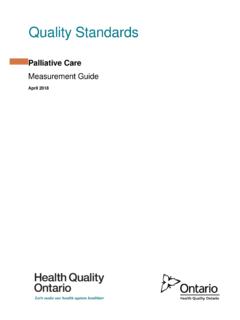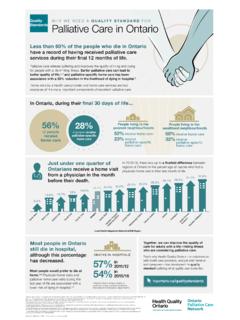Transcription of Health Quality Ontario
1 Health Quality Ontario The provincial advisor on the Quality of Health care in Ontario February 2017 Results from Health Quality Ontario s Benchmark Setting for Long-Term Care Indicators Health Quality Ontario | Setting Achievable Benchmarks for LTC 1 Table of Contents What is a benchmark? .. 1 1. Introduction .. 2 Background .. 2 2. Approach .. 3 Benchmark selection framework .. 3 Benchmark selection panel .. 3 Benchmarking criteria .. 3 Benchmark selection decision tree .. 4 3. Results .. 6 Appropriate for benchmarking .. 6 Not currently appropriate for benchmarking .. 7 4. Conclusion .. 8 Appendix A: Description of steps in process for selecting benchmarks for long-term care home indicators in Ontario .
2 9 Appendix B: Long-term care benchmark setting panel ..11 Appendix C: Indicators and benchmarking expert panel recommendation ..12 What is a benchmark? A benchmark is a point of reference against which others may be measured. Benchmarks should represent a level of excellence and should exceed average performance. HQO s benchmarks are absolute values against which long-term care homes may compare their performance; they are not relative changes, such as a percent decrease or increase in performance from baseline. When long-term care homes meet or surpass the benchmark, it is a marker that the homes are providing high Quality of care for the assessed Quality indicator. Homes that do not meet the benchmark for a particular indicator should consider how far from the benchmark they are and consider developing a Quality improvement strategy that may include multi-year targets to bring their performance closer to the benchmark value.
3 In this way, benchmarks can assist in Quality improvement by representing high Quality of care that long-term care homes can strive to reach. For more information on setting targets and using benchmarks in Quality improvement, refer to Quality Improvement (QIP) Guidance Document for Health Care Organizations, Appendix A: Approaches to Setting Targets for Quality Improvement Plans (2016). Health Quality Ontario | Setting Achievable Benchmarks for LTC 2 1. Introduction Health Quality Ontario (HQO) reports on a set of Quality indicators that balance comprehensive public reporting and focused areas for Quality improvement. Provincial benchmarks for Quality indicators were established to support the long-term care home sector in identifying priority areas and setting local targets for Quality improvement.
4 Benchmarks are numeric values that represent high Quality care and provide a standard against which performance can be compared. In 2015, HQO conducted a review of long-term care Quality indicators and confirmed four previously established benchmarks for four indicators: worsened pressure ulcers, falls, restraints, and worsened symptoms of depression. The review also identified additional indicators to be considered for benchmarking. In the spring of 2016, an expert panel facilitated by HQO recommended one additional indicator that was appropriate for immediate benchmarking: potentially inappropriate antipsychotic use. This report includes the recommended benchmark values, provides a description of the approach that was applied for identifying which of HQO s publicly reported Quality indicators are appropriate for benchmarking and the process that was used for determining the benchmark values.
5 Background Since 2009, HQO has been publicly reporting performance indicators online and in printed reports that measure Quality of care in Ontario long-term care homes. To complement its public reporting, HQO has supported the sector s Quality improvement efforts by providing capacity building activities, private and public reporting tools, and Quality improvement planning. In 2012,1 benchmarks for selected indicators were established as an additional tool to support Quality improvement. Quality Improvement Plans (QIPs) for long-term care homes were initiated in 2014, with all long-term care homes submitting a QIP to HQO the following year. The indicators that HQO publicly reports2 and includes as priorities in QIPs3 were revised in 2015, which initiated a review of the previously established benchmark values and the potential to set benchmarks for new indicators.
6 1 Long-Term Care Benchmarking Resource Guide (2013) 2 LTC Indicator Review Report (2015) 3 Quality Improvement Plans: A Commitment to Improving Quality for the Year Ahead Health Quality Ontario | Setting Achievable Benchmarks for LTC 3 2. Approach Benchmark selection framework Several approaches exist for setting benchmarks, including: - Adopting ideal/theoretical best performance values based on evidence - Selecting values based only on a summary measure of current performance - Using the performance values achieved by the best performers - Choosing values based on expert opinion HQO uses a modified Delphi process and expert panel to establish recommended benchmark values that combines the approaches listed above.
7 HQO s approach enables the selection of benchmarks that are evidence-based and data-driven, represent best performance, and are considered achievable by stakeholders. This approach was applied in the 2015 process to confirm benchmarks for four indicators and in 2016 to select a benchmark for one indicator. For a detailed description of each step in the process, see Appendix A. A similar process for selecting benchmarks had been used previously in Benchmark selection panel An expert panel was convened to guide the selection of the publicly reported indicators appropriate for benchmarking and the benchmark values for these indicators. The panel was comprised of long-term care home and resident council representatives, long-term care home association representatives, researchers, policymakers, and data providers.
8 For a list of the panel members, see Appendix B. Benchmarking criteria To determine which of the publicly reported indicators were appropriate for benchmarking, the expert panel applied the HQO criteria described below to each indicator. For an indicator to be appropriate for benchmarking it should meet the following criteria: - Data Quality should be confirmed ( , indicator validity and reliability), - Variation in performance on the indicator should exist, - High Quality evidence as to what constitutes good performance should be known or performance data should suggest that there are some providers that are top performers on the indicator, and - Quality improvement efforts should be able to impact performance on the indicator. 4 Long-Term Care Benchmarking Resource Guide (2013) Health Quality Ontario | Setting Achievable Benchmarks for LTC 4 Benchmark selection decision tree Figure 1 describes the decision tree that was used to guide the process of determining appropriateness of benchmarking, confirming previously established benchmark values, and identifying new publicly reported indicators for which a benchmark may be established.
9 The panel considered each of the 12 indicators recommended through the 2015 long-term care indicator review for public Group 1: Indicators with a benchmark previously established in Ontario The first group of indicators that the panel considered was the set of four indicators for which benchmarks had previously been established and publicly reported: worsened pressure ulcers, falls, restraints, and worsened mood from symptoms of depression. The objective was to first confirm appropriateness of reporting a benchmark for the indicator and then to determine if the existing benchmark value was still appropriate after reviewing updated performance data, or if the benchmark should be updated or removed. Group 2: Indicators with no benchmark previously established The second group of indicators considered were the remaining eight publicly reported Quality indicators for which benchmarks had not previously been set in Ontario : potentially inappropriate antipsychotic use, worsened mid-loss activities of daily living, improved mid-loss activities of daily living, improved behavioural symptoms, pain, time to long-term care home placement, lost-time injuries per 100 long-term care home worker, and potentially avoidable emergency department visits.
10 The objective was to identify which of these indicators were appropriate for setting benchmarks and to recommend the timing for when benchmarks should be set. Upon completion of the first objective, the second objective was to select benchmark values for indicators deemed appropriate for benchmarking. 5 LTC Indicator Review Report (2015) Health Quality Ontario | Setting Achievable Benchmarks for LTC 5 Figure 1: Decision tree to guide the determination of appropriate indicators for benchmarking and confirming, selecting or removing benchmark value Does the indicator have a benchmark? Yes No Monitor for potential to set benchmark in the future Monitor indicator performance, Quality of data, and changes to indicator specifications Undergo benchmark setting process to establish benchmark value Remove benchmark value.









